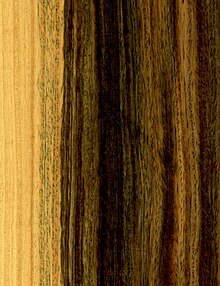

Lignum vitae (/ˈlɪɡnəm ˈvaɪti, -ˈviːtaɪ/[1]), also called guayacan or guaiacum,[2] and in parts of Europe known as Pockholz or pokhout, is a wood from trees of the genus Guaiacum. The trees are indigenous to the Caribbean and the northern coast of South America (e.g., Colombia and Venezuela) and have been an important export crop to Europe since the beginning of the 16th century. The wood was once very important for applications requiring a material with its extraordinary combination of strength, toughness, and density. It is also the national tree of the Bahamas, and the Jamaican national flower.[3]
The wood is obtained chiefly from Guaiacum officinale and Guaiacum sanctum, both small, slow-growing trees. All species of the genus Guaiacum are now listed in Appendix II of CITES (the Convention on International Trade in Endangered Species of Wild Fauna and Flora) as potentially endangered species. G. sanctum is listed as Near Threatened by the IUCN Red List. Demand for the wood has been reduced by modern materials science, which has led to polymers, alloys and composite materials that can take lignum vitae's place.
Various other hardwoods may also be called lignum vitae and should not be confused with it. The best-known come from Bulnesia arborea and Bulnesia sarmientoi (in the same subfamily as Guaiacum) and are known as verawood or Argentine lignum vitae; they are somewhat similar in appearance and working qualities as genuine lignum vitae. Note that these species are now Plectrocarpa arborea and Plectrocarpa sarmientoi. Some hardwoods from Australasia (e.g., Vitex lignum-vitae and some species of Acacia and Eucalyptus) are also referred to as lignum vitae.
- ^ "lignum vitae". Random House Kernerman Webster's College Dictionary (fifth ed.). 2016. Retrieved 23 November 2022 – via TheFreeDictionary.com.
- ^ OED entry
- ^ National Symbols of Jamaica, Jamaica Information Service, archived from the original on 2006-06-19